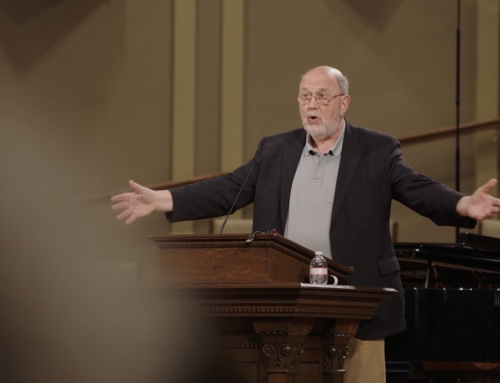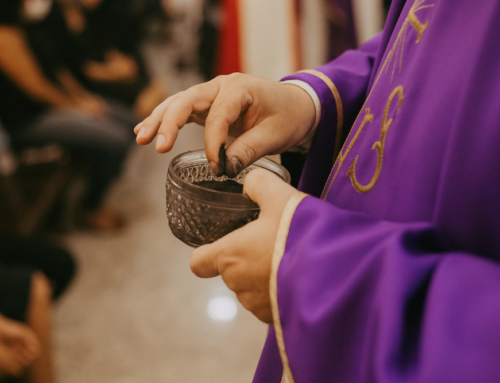Sometimes when my husband, Gary, and I are speaking together at a seminar or conference, he will introduce himself as, ‘Mr. Jennifer Loop’, which always gets a chuckle from the audience. It is fitting because he used to be a former professional stand-up comedian, and even after twenty years of marriage, this ‘bit’ still makes me smile. I know it is Gary’s way of encouraging me to continue speaking, preaching, and writing, when most days I would rather hide instead. My husband’s introduction, which he offers humorously and affectionately, is also, in my view, a nod of support for the ecclesial need to balance the roles of men and women serving and leading together.
In recent days, as our lives have been upended by the COVID 19 pandemic, one slogan I have heard frequently is, ‘together yet apart’. Interestingly, I think this is one way some might answer the question regarding how men and women should relate to one another when it comes to their roles in the Church.
It seems that whilst women are meant to be ‘together’ with men in the Church, they also ought to be ‘yet apart’ in aspects concerning roles of ecclesial authority, or spiritual gifts of preaching, teaching, or leading. These principles are often taken to be a ‘plain sense’ of reading 1 Corinthians 11:1-16, which is one reason why I still have my mantilla (head covering) in the top drawer of our bedroom dresser.
The First Evangelist I Ever Met
Allow me a brief auto-biographical explanation:
The first evangelist I ever met was my elementary school classmate, Jackie, whom I met in fifth grade. Jackie had long brown hair like me, except she wore a red bandana, which I thought was very cool. Plus, none of the boys got her ‘out’ when we played 4-square at recess, which made her even more cool in my eyes. We were both half-Asian, shared a love of cats, and had art class together with Mrs. Campbell. Soon we became good friends, and since my home-life was often quite turbulent, I began hanging out at Jackie’s house almost daily after school.
Jackie seemed self-assured and was non-plussed by peer pressure, which in hindsight could have had a lot to do with the fact that her parents’ small TV was housed on top of their refrigerator. The ever-insecure-and-anxious-nine-year-old me very much wanted to be like Jackie, in all ways, save one. Every weekend Jackie and her family went to church, which she called ‘meeting’. She invited me frequently, but I always made up an excuse and declined.
By high school, I had still managed to evade all of Jackie’s invitations to meeting. The summer of our sophomore year, she invited me to attend a Basic Life Principles Conference at the Oakland Coliseum, which was close to where we lived. For some reason I said yes. As I sat in my seat during a break, I recall feeling like an outsider and yet something on the inside prompted me to say the ‘sinner’s prayer’ that I had just heard about. I said the prayer silently in my seat and then told Jackie I’d said it. When I got home from the conference I got down on my knees and said the prayer again two more times just to make sure it ‘worked’. I didn’t feel anything different—nothing magical happened like I had expected.
After a five-year period of not feeling ‘any different’ one day out of the blue (I would later learn that was likely a ‘prompting of the Holy Spirit’), I asked Jackie if I could attend meeting with her. That Sunday, I put on an ankle-length skirt and borrowed one of Jackie’s hats to cover my head and worshipped with the assembly of Plymouth Brethren gathered in Oakland, CA. I listened and observed whilst the small gathering sang hymns, broke bread, passed the cup, and later as the men read Scripture. I did not have the words to describe what I experienced—it was beyond magical—it was wonder and joy unspeakable.
I continued to worship with this assembly of Plymouth Brethren, and was baptized a few months later, shortly before my 21st birthday. It was, and is, one of my most precious memories, and my love and respect for the brothers and sisters in this assembly remains strong to this day. When I moved from CA to WI, the closest meeting was three hours away. It was a gut-wrenching decision for me to leave fellowship with the Brethren for a different ecclesial context, but I never gave my mantilla back.
Why I Keep My Headcovering
I keep my head covering for several reasons, two of which I offer now. Firstly, I am glad to cover my head where this is practiced as a worshipful sign of submission to male ‘headship’, even though I understand the passage in 1 Corinthians 11 differently. Why? I shall borrow my answer from Morna Hooker’s reflections from Interchange in Christ and Ethics (Journal for the Study of the New Testament, 1985, p. 5):
How should Christians behave towards fellow-Christians with whom they disagree? They must welcome one another, since they have all been welcomed by God himself (Romans 14.1-3). They must be careful not to injure one another by their behaviour, since that would bring destruction on those for whom Christ died (Rom 14.13-21).
In the article, Hooker summarises the words of Irenaeus and describes an ‘interchange’ that takes place whereby ‘Christ became what we are, in order that we might become what he is’ (p. 6). Whilst she admits that ‘interchange’ is not entirely satisfactory because it suggests that Christ and the believer simply change places, what is noteworthy for the discussion about disagreements of authority (‘headship’) in ecclesial practice in general and head coverings in particular, is that ‘interchange’ connotes a ‘mutual give and take’ (p. 6). And, I am reminded that Christ died so that I might become more of a giver than a taker.
Why I Keep My Headcovering Click To TweetThis is what I find to be so much at the heart of Paul’s theology of the Church body’s unity and its diversity. Regrettably, because we are often tempted to think in terms of whose theology is ‘Right’, we miss the fact that Paul was urging the Corinthian church to imitate him by making every effort to please others, not seeking one’s own advantage, but the good of many (1Cor 10.33). Thus, I am content to live within the mysterious ‘interchange’ of life in the Spirit, which means not having all the answers, wrestling with theological tensions, and being very much aware of the fact that just as much as Christ died so that I might stand firm, I might equally be called to stand down by giving up my ‘rights’, covering my head and remaining silent.
Secondly, issues related to what the worshipping Church ought to look like—especially when it comes to models for how women and men relate in the church—are often a conflict over methods of Biblical interpretation and the resulting interpretive conclusions.
Because of the Angels
There are many things to consider when theologising with head coverings ‘because of the angels’ (1Corinthians 11:10b), or that long hair is a woman’s glory (v15), not least of which begins with the non-axiomatic questions Angus Paddison poses in Scripture: a Very Theological Proposal (2009): What is Scripture? What is the task of offering an account of Scripture’s location, whose own overarching question is, In the context of what kinds of action is Scripture intelligible? (5). Paddison suggests we must ‘disentangle our minds from the notion that Scripture is a latent or independent text waiting to be ‘used’ in crisis situations abstracted from thicker contexts of {ecclesial} performance’ (33). Kevin Vanhoozer argues in Biblical Authority After Babel (2016) that ‘sola scriptura’ locates Scripture in the broader pattern as the primary and supreme authority in theology, but not the sole authority (111).
Therefore, I hold open the possibility that continued critical hermeneutical engagement might result in the refinement or revision of my current views on women and men together in ministry (and/or the need for me to don my mantilla). In other words, my attitude as one who prefers to situate herself, as Rowan Williams says, ‘in the middle of things’, begins with my response to those with opposing views: You could be right.
In his latest course covering 1Corinthinans 11-16, Professor N.T. Wright observes that the Apostle Paul was negotiating the issue of men and women in the church ‘cautiously and in an exploratory way’ as he formed arguments for what it meant to embody the celebration of the Church as God’s in-Christ-and-for the Kingdom people. Prof. Wright teaches that for Paul, the crucial issue was the public witness of the church, which remains an important consideration for us today. Paul was concerned that the Corinthian church demonstrate mutual respect, shared leadership, the ‘God-givenness’ of maleness and femaleness, and the need for worship that celebrates we are now like ‘creation restored’.
What might a mutual & shared way of ‘creation restored’ look like in contemporary practice when there are such dissimilar views of what Scripture is saying? Click To TweetSo, what might a mutual and shared way of ‘creation restored’ look like in contemporary practice when there are such dissimilar views of what the ‘truth’ of Scripture is saying to us? How might we reposition the triangulation that situates Christians at the proverbial fork of choosing between complementarianism and egalitarianism? One way forward might be to acknowledge that theology is problematised when our concern for safeguarding theological commitments is prioritised over against safeguarding persons in concrete, lived experience. In my view, an issue plaguing the church for centuries is that hierarchical commitments have been abused in all sorts of ways. Prof. Wright observes, ‘Paul does not think that if women have a place in a hierarchy of being that it is purely in a place of subservience’.
Persons in the Kingdom of God Together
In order to preserve unity we must eschew labels and categories that create impermeable borders and unhelpful binaries, and rather meet as persons in the Kingdom of God together over against the dark forces still at work in the world and the human desire for power and the need to be ‘Right’. We might come together to consider how the Apostle Paul’s letter to Corinth reinvigorates the Church today to cautiously explore new possibilities for the worshipping church and, as Gregory Jones encourages, not limit what God’s Spirit can accomplish by focusing on what is realistically possible’ (Embodying Forgiveness, p. 277). These new horizons of possibility might find convergence that mitigates theologising in ways that are generative of sustaining or reinforcing harmful practices of domination in ecclesial settings.
Putting on different theological shoes might engender understanding for different theological positions that helps us to move forward together. Being bi-racial, I am constantly reminded of the ‘double-vision’ that helps me to see the world from two different cultural perspectives. Today, as I write on May 10th, I am reminded of the historic building of the transcontinental railroad in the mid-19th century, on which many Chinese immigrants worked. Two separate railroads companies started at opposing locations in the country and continued building the track towards each other until on May 10, 1869, Leland Stanford laid the ‘golden spike’ and joined the labours of the Central Pacific Railroad and the Union Pacific Railroad.
Drawing an analogy, we may see that the spikes driven into Jesus Christ catalysed his death and resurrection that drew people collectively towards a divine centre, freeing them from the sequestering power of sin and death. Thus, persons in Christ are now enabled to build together for God’s Kingdom in movements toward one another, until one day when Christ returns to join everything together in himself.
Showing Up for Each Other in the Midst of Our Differences
A couple of years ago, I spoke at a Christian conference (with Mr. Gary Loop in attendance) in California and Jackie and her husband and son attended. I was worried about what they might think of me preaching and teaching. Oddly enough, the topic never came up. Our mutual admiration and love transcend theological differences and merely ‘meeting in the middle’. Rather, what I have discovered is that we both ‘show up’ for each other, in direct response to what God himself did in Jesus of Nazareth by showing up to meet us personally and giving us the gift of the Spirit. And, as our culture continues to evolve and adapt to social distancing and new ways of coming together, this ‘showing up’ personally for one another in the midst of our differences, and building together for God’s Kingdom might be just what the church needs to see and to embody afresh.
Further resources for Theologising with Scripture
Briggs, Richard Reading the Bible Wisely (Grand Rapids, MI: Baker Academic, 2003)
Davis, Ellen F., and Richard B. Hays, The Art of Reading Scripture (Grand Rapids, MI: Eerdmans, 2003)
Paddison, Angus, Scripture : A Very Theological Proposal (London ; New York: T & T Clark, 2009)
Seitz, Christopher R., The Character of Christian Scripture : The Significance of a Two-Testament Bible, Studies in Theological Interpretation (Grand Rapids, Mich.: Grand Rapids, MI: Baker Academic, 2011)
Vanhoozer, Kevin J., Biblical Authority after Babel : Retrieving the Solas in the Spirit of Mere Protestant Christianity (Grand Rapids, MI: Brazos Press, a division of Baker Publishing Group, 2016)
Webster, John, The Domain of the Word : Scripture and Theological Reason (London: T & T Clark, 2012)
Wright, N. T., Scripture and the Authority of God : How to Read the Bible Today. ed. by N. T. Wright. 1st HarperCollins pbk. ed. edn (New York]: New York : HarperOne, 2013)
Jennifer Loop
Latest posts by Jennifer Loop (see all)
- Why You Need Lent: Two Perspectives - February 22, 2023
- How (Not) To Understand a Parable - October 20, 2022
- What People are Saying About ‘Ethnicity, Justice and the People of God’ - February 10, 2022







